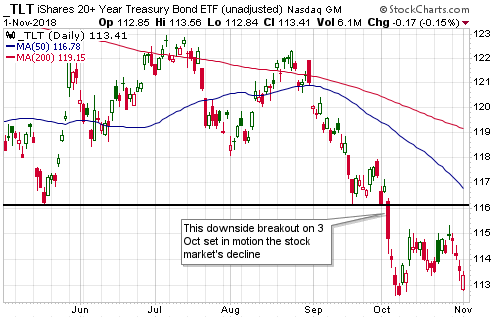The Stocks-Bonds Interplay
It’s normal for the stock market to ignore a rising interest-rate trend for a long time. The reason is that while the interest rate is a major determinant of the value of most corporations, the interest rate that matters for equity valuation isn’t the current one. What matters is the level of interest rates for a great many years to come. Therefore, a rise in interest rates only affects the stock market to the extent that it affects the general perception of where interest rates will be over the next decade or longer.
To further explain, the value of a company is the sum of the present values of all its future cash flows, with the present value of each future cash flow determined via the application of a discount rate (interest rate). Nobody knows what these cash flows will be or what the appropriate discount rate should be, but guesses, also known as forecasts, are made. Clearly, when discounting a set of cash flows spanning, say, the next 30 years, it won’t make sense to simply use the current interest rate. Instead, the analyst doing the calculation will have to make a stab at what will happen to interest rates in the future.
The analyst’s ‘stab’ naturally will be influenced by what is happening in the present, but the future interest rate levels that are plugged into valuation models won’t be adjusted in response to what are considered to be normal fluctuations in the current interest rate. It’s only when the current interest rate breaks out of an established range that it affects expectations in a big way.
That, in a nutshell, is why it isn’t a fluke that the 3rd October downside breakout in the bond market (represented by TLT in the following chart) coincided with the start of a rapid downward re-pricing in the stock market.

In addition to stocks being influenced by big moves (breakouts from ranges) in bonds, bonds are influenced by big moves in stocks. That’s especially so when important stock-market support levels are breached with little warning. For example, within a few days of the 3rd October downside breakout in the bond market setting in motion, a sharp decline in the stock market, the stock market’s weakness was helping to prop-up the bond market. Interestingly, though, the quick 10% decline in the S&P500 Index from its peak led to only a minor rebound in the bond market, despite there being a record-high speculative net-short position in bond futures. As illustrated above, TLT didn’t even manage to rebound by enough to test its 3rd October downside breakout and has dropped back to near its early-October low in response to this week’s recovery in the stock market.
The bond market’s lackluster response to the recent equity weakness suggests that equities will have to weaken further before the interest-rate trend transforms from a stock-market head-wind to a stock-market tail-wind. Also, the fact that the bond market has already dropped back to near its October low suggests that the stock market will be unable to make significant additional gains without pushing interest rates to new multi-year highs. This, in turn, suggests that there is minimal scope for additional short-term strength in the stock market.
Disclosure: None.



